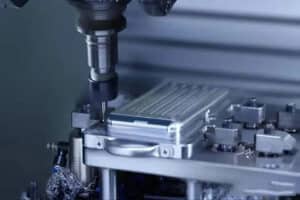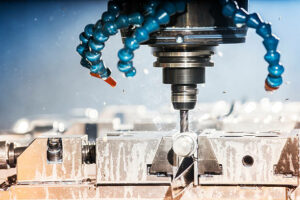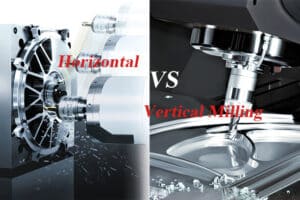What is 4-Axis CNC Machining?
4-axis CNC machining is a type of advanced machining that uses CNC machines with an extra rotating axis. This rotation lets you work on four sides of a part while it remains clamped in one position, requiring only a single setup. This feature enables the creation of intricate parts and the ability to mill at unusual angles, which 3-axis machining can’t do.
4-axis machines come in different styles, but they are commonly found in the ‘vertical machining’ format. In this setup, the spindle moves around the Z-axis. We’ll focus on vertical 4-axis milling here.
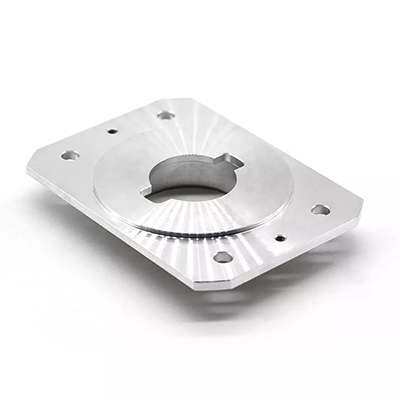
This method involves the usual three axes – X, Y, and Z – like in 3-axis machining, plus an additional A-axis, which rotates around the X-axis. The workpiece is fixed along the X-axis and can rotate with its fixture on the A-axis.
4-axis machining is particularly useful for making cut-outs and holes on the sides of a part or cylindrical surfaces. Using 4-axis machining instead of 3-axis often saves time by reducing the need for multiple setups. It also helps in maintaining precise dimensions on all four sides of a part since it’s held in one setup.
More complex shapes, such as arcs and helices, are more efficiently produced with 4-and 5-axis machining. This approach also makes cutting angled features simpler. However, when using the 4th axis, these angled features must be aligned on the same axis. If the angles vary, the setup (and possibly the fixture) may need to be adjusted for each different angle.
The Benefits of 4-Axis CNC Machining
4-axis CNC machines can create more complex shapes and designs extremely accelerating the production process. In 4-axis CNC machining, the spindle moves in three directions, up and down, left and right, and forth and back, while the workpiece remains stationary. Top-notch manufacturers tend to employ four-axis machining because it enhances part performance while maintaining superior quality. It also offers a wealth of benefits, including higher accuracy, the ability to machine more complex parts, and decreased setup time.
Also, here are the main benefits that a 4-axis machine provides:
1. Versatility
4-axis CNC machines are capable of handling a diverse range of materials and sizes, from small electronic components to large aerospace parts, making them highly adaptable in any manufacturing environment.
3. Improved Flexibility
The ability to move in four directions (X, Y, Z, and A) gives a CNC 4-axis machine an edge over 3-axis machines in terms of accuracy and precision. This extra movement allows for better control during the cutting process and the ability to machine complex shapes more flexibly.
5. Reduced Lead Times
The ability to manufacture complex components in a single setup streamlines the production process, minimizing intermediate handling and repositioning, which significantly cuts down on lead times.
2. Simplify Your Work
Manually operating traditional machines can be time-consuming and labor-intensive. Using a 4-axis CNC machine simplifies these processes, making the operator’s job easier.
4. Enhanced Capabilities
The additional A-axis expands the machine’s ability to create complex parts, which would be challenging with a 3-axis machine. This capability is useful for creating detailed computer-generated models and designing intricate shapes for physical models.
6. Precision and Consistency
The A-axis rotation in 4-axis CNC machining is crucial for achieving exceptional precision. It offers a more consistent machining process compared to traditional methods, where manual repositioning of the workpiece could lead to slight variations.
4 Axis CNC Machining Materials We Work With
Aluminum
Due to its exceptional features such as lightweight, low cost, durability, and machinability, aluminum is one of the typical materials used in 4-axis CNC machining to make many parts for various industrial applications. Learn more...
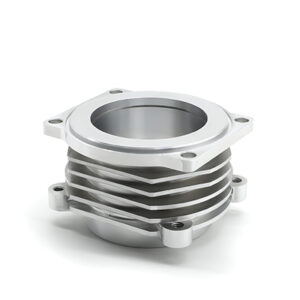
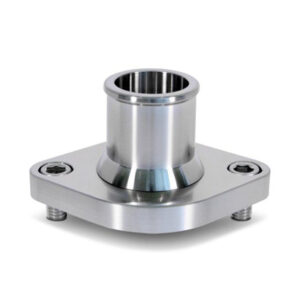
Stainless steel
Stainless steel is an ideal material for 4-axis CNC machining owing to its incredible corrosion and oxidation resistance and machinability. More importantly, its excellent formability and ductility make it fit for the specification requirements of many projects. Learn more...
Titanium
Many industries take advantage of the superior properties of titanium to get complicated components with a high strength-to-weight ratio and biocompatibility, especially for human implants for the medical industry. Learn more...
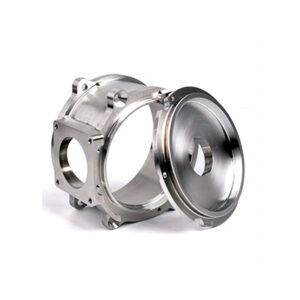
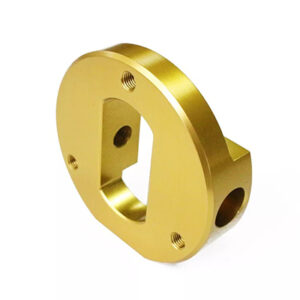
Brass
Given its inherent properties of electrical conductivity, low friction, and corrosion resistance, brass is commonly applied to engineering applications. Runsom Precision can utilize 4-axis CNC machining centers to make precision machined parts made of industrial-grade brass. Learn more...
Acrylic
Acrylic plastic is a great alternative for glass in 4-axis CNC machining relying on its notable natural properties such as excellent rigidity and transparency. Acrylic parts produced by our high-speed machining are usually suited for optical applications. Learn more...
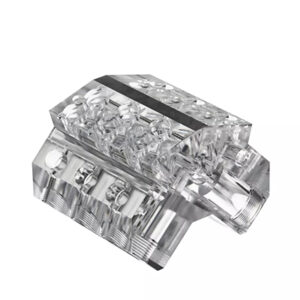
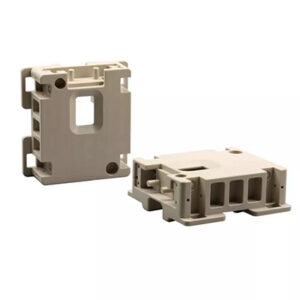
PEEK
PEEK is a type of engineering thermoplastics mostly used in 4-axis CNC machining thanks to its good performance like resilience at high temperatures and abrasion resistance, greatly suitable for applications requiring high thermal and chemical properties. Learn more...
Why Choose Us?
1. Technical Expertise
You may rest assured that we have an engineering team with rich experience in complex projects, advanced production, inspection equipment, and mature management systems.
3. Competitive Price
We have optimized the manufacturing process combinations along with the latest CNC technologies, which will greatly save production costs with improved production capabilities and efficiency.
5. State-of-the-art Equipment
Our machine shop is equipped with advanced 4 axis CNC machining equipment to effectively process parts of any size and shape, eliminating several inadequacies of conventional CNC machining techniques.
2. Quality Reliability
Certificated by ISO 9001:2015, we have strict requirements for quality. To reach high-quality machined parts, we have a sound quality control system and well-equipped measuring devices.
4. On-time Delivery
The lead time will be shortened under the operation of our experts whether for time-costing manual tasks or repetitive automating tasks. You can get an instant quote within 24h and receive your parts within the agreed delivery date.
6. Excellent Parts Accuracy
We can process your parts with a tolerance as tight as +/-0.01 mm using our 4-axis CNC machining centers. With more than ten years of precision CNC machining service, we have delivered parts with incredible accuracy to customers worldwide.
4 Axis CNC Machining FAQs
The 4-axis CNC machine adds a rotation around the X-axis, called the A-axis. The spindle has 3 axes of linear motion (X-Y-Z), just like a 3-axis machine, the additional A-axis functions through the rotation of the workpiece. 4-axis machines come in a few different arrangements but are usually of the “vertical machining” type, where the spindle rotates around the Z axis. The workpiece mounted on the X axis can rotate with the fixture on the A axis. Thus, four faces of the part can be machined for a single setup.
A 4-axis CNC machine operates on the X-, Y-, Z-axis and an additional axis of rotation, which usually revolves around the X axis. This fourth axis is called the A-axis.
The advantages of 4 axis CNC machining are shown as follows:
- Simple setup
- Efficient machining
- Incredible surface finish
- High precision and safety
- Low tool wear
- High-speed milling
- Shorter production run
- Multiple functions
- Greater dimensional accuracy
- Machined parts with excellent physical properties
The two most popular types of 4-axis CNC machining are indexing and continuous respectively.
- Indexing: This involves the process where the 4th axis (A-axis) performs the rotation while the machine is idle and not extracting any material.
Continuous: In this process, the machine can simultaneously cut material while the A-axis rotates. This allows complex arcs to be machined, such as helixes and the profile of cam lobes. - 4-axis machining is capable to machine angular features that are otherwise impossible on 3-axis machines. Note that four-axis machining allows a single axis of rotation per fixture setup, so features at all angles must be angled around the same axis, or an additional fixture placed.
The major difference between 3-, 4-, and 5-axis machining is the axis motion that occurs between the workpiece and the cutting equipment. The higher complexity of motion between the two parts helps machinists create parts with more complex geometries for a wide range of industries. The number of axes demonstrates the intricacy of the milling process that the machine can perform, the level of sophistication that can be achieved when milling components, and points of the workpiece that the machine can process.
3-axis machining is suitable for parts that do not require lots of high detail and depth, so it is an ideal choice for projects without the requirement to machine complex geometries. Choose 4-axis milling if you want to create complex 3D shapes or mill the tilted surfaces of components while maintaining high precision. If your components are used in aerospace, medical, or other crucial fields in need of sophisticated shapes, ultimate precision, accuracy, and quality, 5-axis machining is the way to go.
Choosing the appropriate type of four-axis CNC machining center can be a bit tricky due to the variety available. Here are some factors to consider when making your decision:
1. Consider the Part Geometry
Evaluate the design of your part to decide if you need a 4-axis CNC machine with both milling and turning capabilities or just one of these functions.
2. Batch Size and Machine Configuration
If you plan to machine a large batch of parts, a 4-axis CNC machine equipped with a tombstone might be the best choice, as it allows for the simultaneous machining of multiple parts.
3. Vertical vs. Horizontal Orientation
If your work involves multiple flat parts and requires less clearance, a vertical four-axis CNC machine will likely suffice. However, for jobs needing more clearance, a horizontal four-axis machine is preferable.
4. Curved Features and Machining Type
For machining curved features, a simultaneous four-axis CNC machine is typically necessary. If your project doesn’t require this level of complexity, then a positional (3+1) four-axis CNC machining center would be a suitable option.

